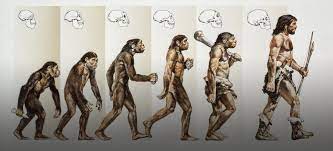Introduction
Through the study of human evolution, one can discover a fascinating journey through time, which involves investigating the lineage of our ancestors. Homo Habilis, Homo Erectus, and Homo Neanderthals are three important species that have a strong connection to the anatomical background of humans. Can you tell me what happened to these species? Do any of them still take place today? These ancestors play a significant role in the history of modern humans, also known as Homo sapiens. Nevertheless, the most important question remains: has the process of evolution in humans come to a halt, or do we continue to evolve? In this video, which is the second installment of the Theory of Evolution series, we delve into these inquiries and attempt to unravel the mysterious story of human history.
From the Beginning of Life to the End of the Dinosaur Era
In the video that came before this one, I had the opportunity to travel through the history of life on Earth and investigate the various forms of life that appeared before. The story continued all the way up until the time when dinosaurs became extinct. As we move forward, let us continue our journey and reveal the story of the evolution of humanity.
The Great Apes represent the closest relatives.
The Great Apes, which include Chimpanzees, Gorillas, Orangutans, and Bonobos, are our closest living relatives, and we will begin our exploration with them. These apes, along with humans, are classified as Hominids because they share a number of characteristics, including the ability to walk on two legs and the types of blood groups they have.
How Hominoids and Anthropoids Are Related to One Another
When we take a step back in the evolutionary chain, we observe the emergence of hominoids, which include gibbons that share an astonishing 96% DNA similarity with humans. Extending further, Anthropoids appear, which are composed of a variety of monkeys and have characteristics that seem to be similar to humans.
Primates
The Primate category includes both Tarsiers and Lemurs, both of which have characteristics that are unique to them. The shy and nocturnal tarsiers are known for their extraordinary jumping abilities, while the Lemurs, which are native to Madagascar, carry the distinction of being the oldest living primates.
Understanding Evolution Through the Lens of a Tree with Many Branches
When evolution is compared to a tree, it can be seen as a tree that branches off into different categories. As we travel backward, we will find convergence points that reveal common ancestors, which will shed light on the relationship between modern-day animals and humans.
A Trip Through Hominins: Our Ancestral Lineage and Their Development
When we venture into the realm of Hominins, we come across a number of different species, one of which is Ardipithecus Ramidus, which was the extremely first species to exhibit bipedalism. Additional species, such as Australopithecus Afarensis, which is represented by the well-known fossil known as “Lucy,” displayed more advanced bipedal characteristics and the ability to use tools.
Between the time of Homo Habilis and Homo Erectus
The appearance of Homo Habilis, also referred to as “handyman,” demonstrated a significant advancement in the utilisation of tools and the scavenging of resources. The Homo erectus, also known as the “working man,” demonstrated significant advancements in the areas of hunting, toolmaking, and the utilisation of fire.
Homo sapiens: The rise of the Wise Man
The culmination of evolution is the species that we are, Homo sapiens, which demonstrates remarkable advancements in intelligence, creativity, and the development of society. The path that led to the development of modern Homo sapiens was paved by archaic Homo sapiens.
Extinct Cousins: Homo Neanderthals and Beyond
residing on Homo Neanderthals, Homo Denisovans, and Homo Floresiensis, which were species that coexisted with Homo Sapiens but fell victim to extinction in the long run. It is investigated how Homo Neanderthals overcame the obstacles that led to their eventual demise, as well as the genetic legacy that they left behind in modern humans.
Homo sapiens are still evolving in their species.
When considering the evolution of humans, contemporary evidence suggests that Homo sapiens continue to exhibit evolutionary characteristics. These characteristics are visible in the variation of skin colour and lactose tolerance across populations. The ongoing nature of human evolution is demonstrated by the evolutionary adaptations that have occurred in response to changes in the environment and in diet.
Secrets of the Ancestral Journey Beyond Humans
Taking a look back at the history of human evolution, it is essential to comprehend that our origins extend beyond primates. In order to gain a better understanding of the fascinating story of the evolution of life, it is necessary to investigate our relationship with vertebrates, mammals, and the last universal common ancestor, also known as LUCA.
A Journey of Epic Proportions: From Stardust to Life
Reflecting on the beginnings of life, beginning with the formation of stardust and progressing to the formation of our solar system and, ultimately, the beginning of the Earth, is a way to trace the story of the emergence of life. The journey from the smallest cell to complex organisms is illustrative of the great complexity that has been present throughout the evolution of life.
Conclusion
A captivating story is encapsulated in the process of human evolution, which is a complex tapestry that weaves through a wide variety of species and intricate characteristics. This narrative, which begins with the earliest forms of life and ends with Homo sapiens, offers a glimpse into an evolutionary journey that is rich in resiliency, adaptation, and continuity.

 Cart is empty
Cart is empty 